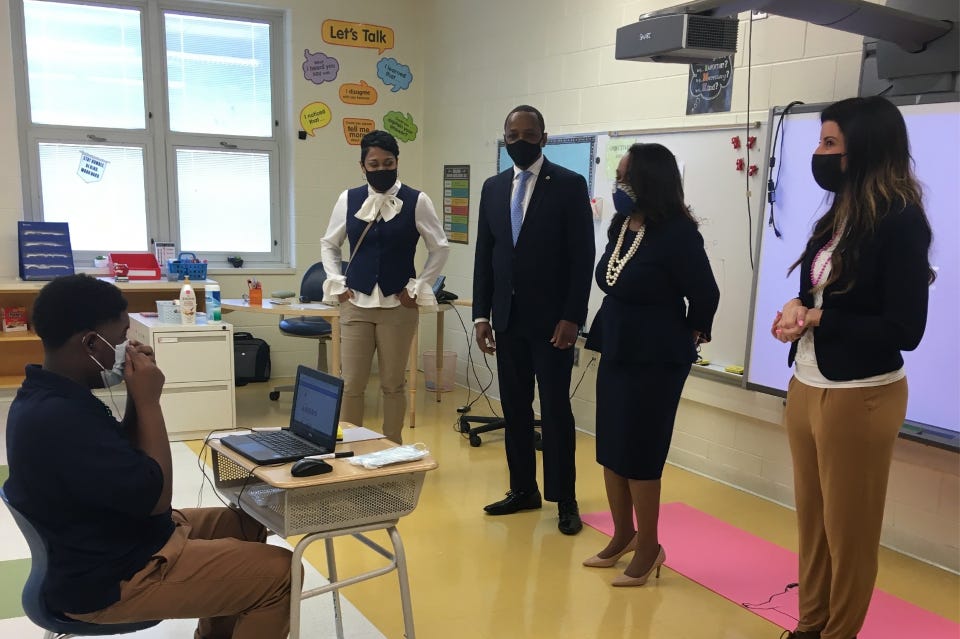For Black Teachers, Local Context Matters
Teachers of color teach at disproportionate percentages to the percentage of students of color. Therefore, all schools must do a better job at hiring & retaining Black teachers
Rann Miller | Guest Contributor
I recently saw a tweet detailing the current racial demographics of teachers of color when comparing traditional public schools and charter schools …
Currently, according to the National Center for Education Statistics (NCES), Charter schools have a higher percentage of teachers of color, notably more Black teachers, in their classrooms compared to public (and private) schools.
Charter schools employ higher percentages of Black and Latinx teachers. The reason why warrants more discovery and investigation (not done here). For the purpose of increasing teachers of color in public schools, specifically Black teachers, the philosophy of charters for hiring Black teachers deserves deeper examination.
However, national data tells an incomplete story.
First, left out is that generally, where there are more students of color, there are more teachers of color – this is true for Black teachers.
According to NCES, as the population of students of color becomes more concentrated in a school, the percentages of teachers of color increase …
There are several reasons for this, not limited to the possibility that teachers of color wish to teach where there are greater numbers of students who look like them. There is also the possibility that teachers of color aren’t hired where there isn’t a sizable population of students of color.
In the case of charter schools, fewer White students attend charter schools when compared to students of color. Black and Latinx students make up the majority of charter school students and the most charter schools are in cities, where Black and Latinx students live. Therefore, charter schools will always have higher percentages of teachers of color – not necessarily because charter schools are committed to hiring them, although they may be, but primarily because teachers of color want to work with students of color.
Secondly, all charter schools are not created equal. Charter schools may mean and do different things depending on what part of the country they are located in.
A Jersey Story
In New Jersey, like many states, traditional public schools and charter schools co-exist. However, in cities like Camden, New Jersey, the two categories of schools are in stiff competition for students. Parents who decide between where to send their children have their pick in Camden and the demographics of teachers may be a deciding factor.
Camden has three school entities like most municipalities; public schools, charter schools and private (religious) schools. Charter schools in New Jersey can either be traditional charter, charters that are local to the city starting from scratch, or a renaissance charter, usually a charter management organization with a regional or national network that takes over a “failing” school.
Nationally, teacher and educator demographics may say one thing, but they might mean something different when the focus narrows. This is true for Camden.
In Camden City, according to the New Jersey Department of Education (NJDOE), traditional public school teachers are more diverse than charter schools. That includes traditional charters or renaissance charters. The same is true for supervisors (i.e. curriculum, special services, etc.) and administrators of color when comparing traditional public and charter schools in the city.
No matter the school, the student population is similar throughout the city. Sadly, the same cannot be said for educator demographics. To be fair, however, the statistics for charter schools are better than national statistics for both public and charter schools.
However, a true comparison in this case is a comparison to one’s peer group. When compared to Camden City Schools, neither category of charter schools is doing better.
The same is true when focusing specifically on Black educators in Camden.
According to the NJDOE, traditional public schools have more Black educators, among teachers, supervisors and administrators, than charter schools. This is after the reduction of Black teachers specifically due to school closures in the city – detailed in a report by New Jersey Policy Perspective. Again, the charter school data (the date provided) is better than national statistics, but a comparison with Camden City schools provides better context on what educator diversity is for Black educators.
One could argue that one state or one city in one state does not speak for a broader or national trend. This is true. However, my highlighting one city in one state is to draw attention to the reality that when having discussions about teacher diversity to compare one category of schools against another, local context matters.
Regardless of where, teachers of color teach at disproportionate percentages to the percentage of students of color—nationally and in Camden. Therefore, all schools must do a better job at hiring and retaining Black teachers. No one set of schools has a leg up on others. All schools have work to do.








